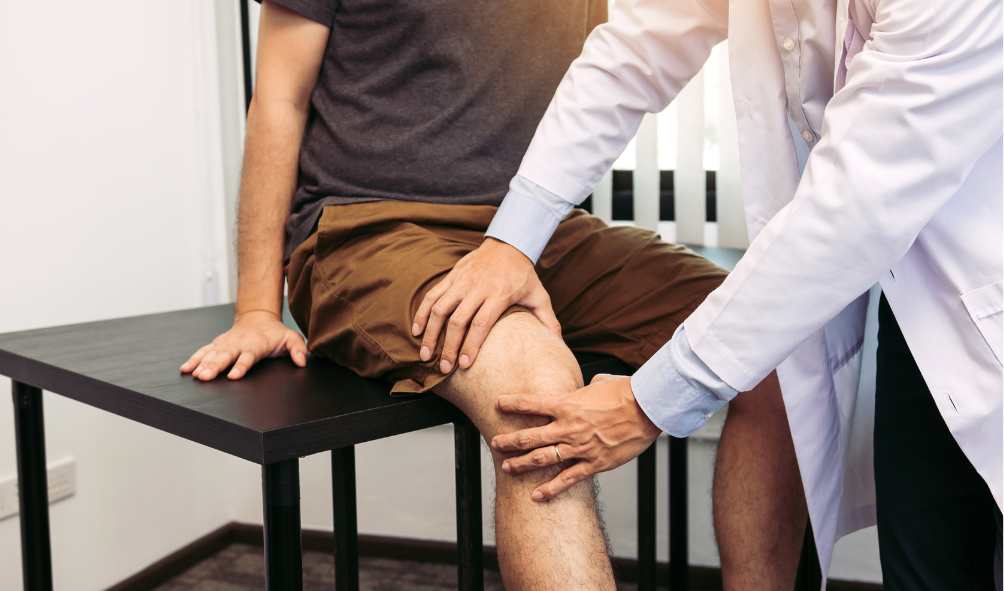
Orthopaedics Doctor in Dum Dum specialize in treating conditions related to the musculoskeletal system, which includes bones, joints, muscles, ligaments, tendons, and nerves. The treatments provided by orthopedic doctors can vary widely depending on the specific condition and its severity. Here are some common treatments and procedures that Orthopaedics Doctor in Dum Dum may offer:
- Medications: Orthopedic doctors may prescribe medications such as anti-inflammatory drugs, pain relievers, muscle relaxants, or antibiotics to treat various musculoskeletal conditions.
- Physical Therapy: Physical therapy involves exercises, stretches, and other therapeutic techniques to improve mobility, strength, and function, and to alleviate pain. Orthopedic doctors often work closely with physical therapists to develop personalized treatment plans for their patients.
- Orthotics: Orthotic devices, such as braces, splints, or orthopedic shoe inserts, may be recommended to provide support, stability, and alignment for injured or weakened joints and muscles.
- Casting and Splinting: For fractures and other bone injuries, orthopedic doctors may apply casts or splints to immobilize the affected area and promote healing.
- Joint Injections: Injections of corticosteroids or viscosupplements (hyaluronic acid) into joints can help reduce inflammation, relieve pain, and improve mobility in conditions such as osteoarthritis.
- Surgery: Orthopedic surgeons are trained to perform various surgical procedures to repair or reconstruct damaged bones, joints, ligaments, tendons, or muscles. Common orthopedic surgeries include joint replacement (e.g., knee or hip replacement), arthroscopic surgery, fracture repair, and spinal surgery.
- Minimally Invasive Procedures: Advances in technology have led to the development of minimally invasive techniques for many orthopedic procedures, such as arthroscopy, which involves inserting a tiny camera and surgical instruments through small incisions to diagnose and treat joint problems with less tissue damage and faster recovery times compared to traditional open surgery.
- Regenerative Medicine: Emerging treatments in orthopedics involve the use of regenerative techniques such as platelet-rich plasma (PRP) therapy, stem cell therapy, and growth factor injections to stimulate tissue repair and regeneration in conditions like tendon injuries and osteoarthritis.
- Lifestyle Modifications: Orthopedic doctors may also advise patients on lifestyle changes, such as weight management, exercise modifications, ergonomic adjustments, and injury prevention strategies, to improve overall musculoskeletal health and prevent future problems.
The specific treatment approach recommended by an orthopedic doctor will depend on factors such as the patient’s medical history, diagnosis, symptoms, lifestyle, and preferences. It’s important for patients to communicate openly with their orthopedic doctor and actively participate in their treatment plan to achieve the best possible outcomes.
Orthopaedics Doctor in Dum Dum specialize in treating conditions related to the musculoskeletal system, which includes bones, joints, muscles, ligaments, tendons, and nerves. The treatments provided by orthopedic doctors can vary widely depending on the specific condition and its severity. Here are some common treatments and procedures that Orthopaedics Doctor in Dum Dum may offer:
- Medications: Orthopedic doctors may prescribe medications such as anti-inflammatory drugs, pain relievers, muscle relaxants, or antibiotics to treat various musculoskeletal conditions.
- Physical Therapy: Physical therapy involves exercises, stretches, and other therapeutic techniques to improve mobility, strength, and function, and to alleviate pain. Orthopedic doctors often work closely with physical therapists to develop personalized treatment plans for their patients.
- Orthotics: Orthotic devices, such as braces, splints, or orthopedic shoe inserts, may be recommended to provide support, stability, and alignment for injured or weakened joints and muscles.
- Casting and Splinting: For fractures and other bone injuries, orthopedic doctors may apply casts or splints to immobilize the affected area and promote healing.
- Joint Injections: Injections of corticosteroids or viscosupplements (hyaluronic acid) into joints can help reduce inflammation, relieve pain, and improve mobility in conditions such as osteoarthritis.
- Surgery: Orthopedic surgeons are trained to perform various surgical procedures to repair or reconstruct damaged bones, joints, ligaments, tendons, or muscles. Common orthopedic surgeries include joint replacement (e.g., knee or hip replacement), arthroscopic surgery, fracture repair, and spinal surgery.
- Minimally Invasive Procedures: Advances in technology have led to the development of minimally invasive techniques for many orthopedic procedures, such as arthroscopy, which involves inserting a tiny camera and surgical instruments through small incisions to diagnose and treat joint problems with less tissue damage and faster recovery times compared to traditional open surgery.
- Regenerative Medicine: Emerging treatments in orthopedics involve the use of regenerative techniques such as platelet-rich plasma (PRP) therapy, stem cell therapy, and growth factor injections to stimulate tissue repair and regeneration in conditions like tendon injuries and osteoarthritis.
- Lifestyle Modifications: Orthopedic doctors may also advise patients on lifestyle changes, such as weight management, exercise modifications, ergonomic adjustments, and injury prevention strategies, to improve overall musculoskeletal health and prevent future problems.
The specific treatment approach recommended by an orthopedic doctor will depend on factors such as the patient’s medical history, diagnosis, symptoms, lifestyle, and preferences. It’s important for patients to communicate openly with their orthopedic doctor and actively participate in their treatment plan to achieve the best possible outcomes.
